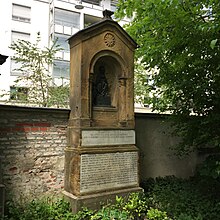Franz Streber
Franz Streber (born February 26, 1806 in Deutenkofen , † November 21, 1864 in Munich ) was a German numismatist and archaeologist , first professor of archeology at the University of Munich and head of the Royal Coin Cabinet in Munich.
Life
Streber, son of a patrimonial judge , studied theology in Landshut and Munich and graduated in 1827. In addition, he began to deal with archeology, art history and numismatics. In 1827 he began to work as an assistant ( Amanuensis ) at the Royal Coin Cabinet in Munich, which was led by his uncle, the Munich auxiliary bishop and numismatist Franz Ignaz von Streber . After studying in Vienna in 1829, he was appointed adjunct of the Münzkabinett in 1830 and received his doctorate in Erlangen in 1831 . In 1834 he became an extraordinary member of the Bavarian Academy of Sciences . In 1835 the University of Munich appointed him associate professor and in 1840 full professor of archeology, art history and aesthetics. In 1843/44 and 1852/53 he was rector of the university. After the death of his uncle in 1841 he took up the position of head (curator) of the coin cabinet, which he remained until his death.
Streber has distinguished himself through a number of publications in the field of numismatics. His contributions to the Celtic rainbow bowls , based on the Irsching find, on "The oldest coins struck in Salzburg" (Munich 1855) and various smaller treatises on medieval coinage were of particular importance .
tomb
The tomb of Franz nerd is on the old southern cemetery in Munich (wall right place at 321/322 burial ground 18) location . The auxiliary bishop, numismatist and head of the Bavarian Coin Cabinet Franz Ignaz von Streber (1758–1841) was an uncle of Franz Streber and lies in the same grave.
literature
- Sigmund Riezler : Streber, Franz . In: Allgemeine Deutsche Biographie (ADB). Volume 36, Duncker & Humblot, Leipzig 1893, p. 553 f.
- Harald Küthmann In: From the Royal Cabinet to the State Collection, 1807-1982 . Exhibition catalog of the State Coin Collection Munich, 1982, p. 207.
Web links
Remarks
- ↑ Franz Streber: About the so-called rainbow bowl . In: Treatise of the royal baier. Academy of Sciences Vol. 9, 1 (1860) and 9, 3 (1862).
| personal data | |
|---|---|
| SURNAME | Streber, Franz |
| ALTERNATIVE NAMES | Streber, Franz Seraph (full name); Nerd, Franciscus |
| BRIEF DESCRIPTION | German numismatist and archaeologist |
| DATE OF BIRTH | February 26, 1806 |
| PLACE OF BIRTH | Deutenkofen |
| DATE OF DEATH | November 21, 1864 |
| Place of death | Munich |
